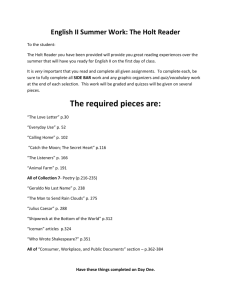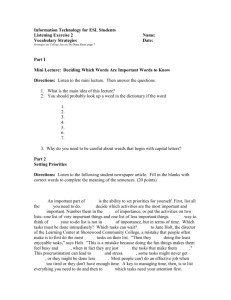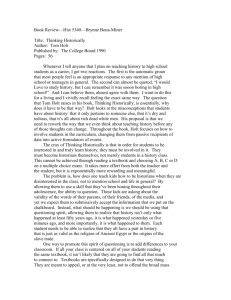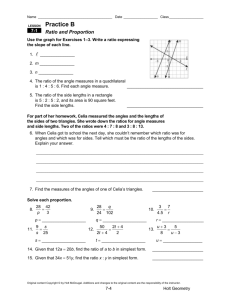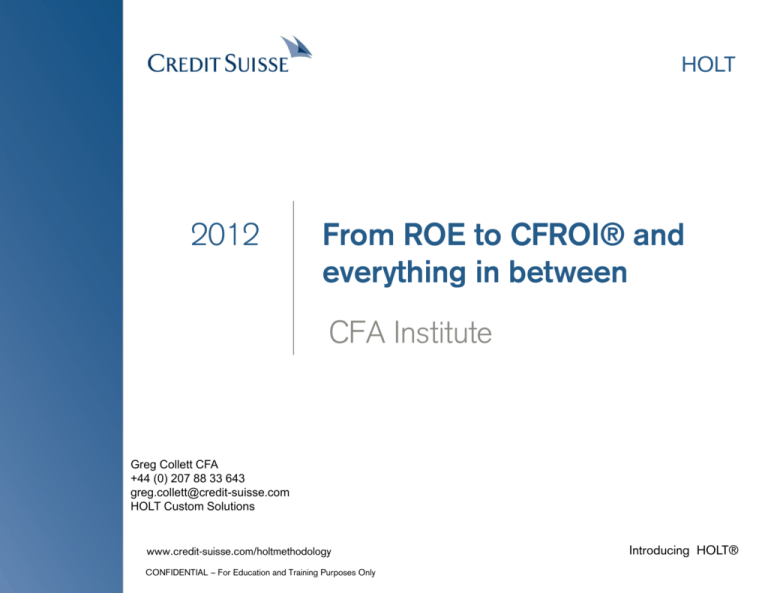
HOLT
2012
From ROE to CFROI® and
everything in between
CFA Institute
Greg Collett CFA
+44 (0) 207 88 33 643
greg.collett@credit-suisse.com
HOLT Custom Solutions
www.credit-suisse.com/holtmethodology
CONFIDENTIAL – For Education and Training Purposes Only
Introducing HOLT®
Agenda
Introduction
Accounting
Performance Measurement
Fade and Mean Reversion
Link to Valuation
Questions
CLARITY IS CONFIDENCE
HOLT
Accounting – how it all flows around
CLARITY IS CONFIDENCE
HOLT
The Ideal Performance Metric
Question
Problem
Does the metric allow fair comparisons
between old and new companies?
New assets = low return
Old assets = high return
How do you compare a short life tech
company to a longer life capital goods
company?
Ratio vs IRR
Can you compare returns across
countries with high and low inflation?
Income statement reflects inflation
Balance sheet to a lesser extent
Do the return and growth measures
track Total Shareholder Return (TSR)
over time.
Does a rising return lead to greater
TSR?
Is the return measure subject to
accounting manipulation?
Financing manipulation does not always
improve TSR
CLARITY IS CONFIDENCE
HOLT
The Ideal Performance Metric
Question
ROE
ROIC
Old Assets/New
Assets
?
?
?
?
?
Asset Life
?
?
?
?
?
Inflation
?
?
?
?
?
Accounting
Distortions
?
?
?
?
?
CLARITY IS CONFIDENCE
CROGI CROIGI CFROI
HOLT
Comparison of Financial Performance Metrics
Cash Flow
Return on
Investment
Cash Return on
Inflation
Adjusted Gross
Investment
Cash Return on
Gross
Investment
CFROI
CROIGI
CROGI
Return on
Invested Capital
ROIC
Return on Equity
ROCE
ROE
CLARITY IS CONFIDENCE
ROIIC
RONA
HOLT
Return on Equity
ROE is defined as Net Earnings / Book Equity.
It is an incomplete measure because it measures
CFROI
the return on assets not funded by debt.
CROIGI
CROGI
ROIC
Return on Equity
ROE
CLARITY IS CONFIDENCE
HOLT
Return on Equity – Changing Leverage Adds Noise to the Signal
Income
Costs
EBIT
Interest
PBT
Tax
Net Income
Debt
Equity
Deb/(Debt+Equity)
ROE
1000
700
300
100
200
60
140
1000
700
300
90
210
63
147
1000
700
300
80
220
66
154
1000
700
300
70
230
69
161
1000
700
300
60
240
72
168
1000
700
300
50
250
75
175
1000
700
300
40
260
78
182
1000
700
300
30
270
81
189
1000
700
300
20
280
84
196
1000
700
300
10
290
87
203
1000
700
300
0
300
90
210
1000
0
100%
#N/A
900
100
90%
147%
800
200
80%
77%
700
300
70%
54%
600
400
60%
42%
500
500
50%
35%
400
600
40%
30%
300
700
30%
27%
200
800
20%
25%
100
900
10%
23%
0
1000
0%
21%
1,200
160%
140%
1,000
120%
800
100%
600
80%
60%
400
40%
200
20%
0
0%
1
2
3
4
5
Debt
CLARITY IS CONFIDENCE
6
Equity
7
8
9
10
11
ROE
HOLT
Understanding Inflation’s Impact on ROE
LIFO
Revenue
- Expenses
Profit
Net Income
ROE
=
Owner’s Equity
CLARITY IS CONFIDENCE
Inventory
FIFO
Wages
Depreciation
~
~
HOLT
Inflation Can Seriously Distort ROE
20
Reported
ROE
Reported ROE
using actual U.S.
inflation for a 6%
“real” IRR
project.
15
10
6% IRR Project
(Inflation Adjusted)
5
0
1870
1880
1890
1900
1910
1920
1930
1940
1950
1960
1970
1980
1990
HOLT
CLARITY IS CONFIDENCE
Source: HOLT analysis
Return on Equity
Issue
Old Assets/New
Assets
ROE
Reason
No
Neither net income nor equity
refect asset age
No
Neither net income nor equity
refect asset life
No
Net income reflects inflation. Equity
is an historical value
Accounting
Distortions
No
Both are subject to non-operating
distortions
TSR Tracking
No
Tracks poorly
Asset Life
Inflation
CLARITY IS CONFIDENCE
HOLT
Return on Invested Capital
ROIC is defined as NOPAT / Invested Capital and is key to Economic Profit analysis.
CFROI
CROIGI
CROGI
Return on
Invested Capital
ROIC
ROCE
ROE
CLARITY IS CONFIDENCE
ROIIC
RONA
HOLT
Return on Invested Capital
Operating Profit (EBIT)
- Effective Tax Charge
= NOPAT (Net Operating Profit After Tax)
ROIC =
NOPAT
Invested Capital
Total Assets
- Payables
- Other Current Liabilities
- Cash
= Invested Capital
CLARITY IS CONFIDENCE
HOLT
Return on Invested Capital – Issues
Current Dollar income which includes
noncash items such as depreciation
and amortisation
ROIC =
NOPAT
Invested Capital
Can we expect this ratio to tell
us anything useful about
performance?
NOPAT and Invested Capital
are not in constant dollars!
Historical cost depreciated assets
Excludes off balance sheet items
CLARITY IS CONFIDENCE
HOLT
Accounting Items Can Distort the Return Calculation
Example: Two Plants
•
Managers A and B operate plants of equal capacity but with different ages
•
Plants each have 20 year life, original cost of assets = 1,000
Plant A
Plant B
NOPAT
100
100
Age of Assets
10
0
Invested Capital
500
1,000
ROIC
20%
10%
CLARITY IS CONFIDENCE
Manager B is
penalized for
having a newer
plant!
HOLT
Worldwide Accounting and Reporting Issues Prevent Comparability
CLARITY IS CONFIDENCE
HOLT
Return on Invested Capital
Issue
Old Assets/New
Assets
Asset Life
ROIC
Reason
No
Asset age reduces assets
No
Not taken into account
NOPAT is current dollars,
Inflation
No
Invested Capital is not
Depends on analyst
Accounting Distortions Maybe
adjustments (op leases)
CLARITY IS CONFIDENCE
HOLT
Cash Return on Gross Investment
CFROI
Cash Return on
Gross
Investment
CROIGI
CROGI
ROIC
ROE
CLARITY IS CONFIDENCE
HOLT
Cash Return on Gross Investment
NOPAT
+Depreciation
+Other non-cash
Operating After
Tax Cash Flow
CROGI
=
items
Gross Investment
Invested Capital
+
ROIC
Accumulated
Depreciation
+
ROE
Capitalized
Expenses
... by adding back non-cash items to NOPAT and accumulated depreciation to
Invested Capital
This captures the total value of investment in the asset base more accurately
CLARITY IS CONFIDENCE
HOLT
Cash Return on Gross Investment
Example: Two Plants
CLARITY IS CONFIDENCE
Plant A
Plant B
NOPAT
100
100
Depreciation
50
50
Operating After Tax
Cash Flow
150
150
Invested Capital
500
1,000
Accum ulated
Depreciation
500
0
Gross Investment
1,000
1,000
CROGI
15%
15%
CROGI shows that
managers A and B
are achieving
similar cash returns
on the original
investment!
HOLT
Cash Return on Gross Investment – Operating Leases
Plant A Plant B Plant C
NOPAT
100
100
100
Depreciation
50
50
0
Operating Leases
0
0
50
Operating After
Tax Cash Flow
150
150
150
Invested Capital
1,000
1,000
0
500
0
0
0
0
1,000
1,000
1,000
1,000
15%
15%
15%
Accumulated
Depreciation
Gross Capitalised
Leases
Gross
Investm ent
CROGI
CROGI shows that
managers A, B and
C are achieving
similar cash returns
on the original
investment!
These scenarios assume zero net working capital
CLARITY IS CONFIDENCE
HOLT
Cash Return on Gross Investment
Net PPE/Gross PPE
PPE Life
0.56
25.00
0.54
20.00
0.52
15.00
0.50
10.00
0.48
5.00
0.46
0.44
2011
2010
2009
2008
2007
2006
2005
2004
2003
2002
2001
2000
1999
1998
1997
1996
1995
1994
1993
1992
1991
2011
2010
2009
2008
2007
2006
2005
2004
2003
2002
2001
2000
1999
1998
1997
1996
1995
1994
1993
1992
1991
0.00
The Net/Gross plant ratio tells us that the PPE is
50% depreciated.
Capex/Depreciation
2.5
Capex/Depreciation is greater than one indicating
net growth
2.0
1.5
Plant life (GrossPPE/depreciation) has increased.
This could be caused by changes in sector
composition and weight over time.
1.0
0.5
2011
2010
2009
2008
2007
2006
2005
2004
2003
2002
2001
2000
1999
1998
1997
1996
1995
1994
1993
1992
1991
0.0
HOLT
CLARITY IS CONFIDENCE
Europe>1bn Eur ex Financials. Source Credit Suisse HOLT 2 Oct 2012
Cash Return on Gross Investment
Issue
Old Assets/New
Assets
Asset Life
CROGI
YES
No
Reason
Accumulated depreciation is
added back
Not taken into account
Cash flow is current dollars,
Inflation
No
Invested Capital is historical
Depends on analyst
Accounting Distortions Maybe
adjustments (op leases)
CLARITY IS CONFIDENCE
HOLT
Cash Return on Gross Investment
From an investor’s point of view…..
What is the impact of inflation on the
investment made ten years ago?
Are you measuring return on what you
spent ten years ago or on what that
investment is worth in today’s money
(current Dollars)?
CLARITY IS CONFIDENCE
HOLT
Differing Inflation Rates Make International Comparisons Difficult
Can you use CROGI to compare companies across time and in different countries?
HOLT
CLARITY IS CONFIDENCE
Source Credit Suisse HOLT 2 Oct 2012
Cash Return on Inflation Adjusted Gross Investment
CROIGI is defined as Cash Return / Inflation Adjusted Gross Investment.
Cash Return on
Inflation
Adjusted Gross
Investment
CFROI
CROIGI
CROGI
ROIC
ROE
CLARITY IS CONFIDENCE
HOLT
Cash Return on Inflation Adjusted Gross Investment
Operating After Tax
Cash Flow
Operating After Tax
Cash Flow
CROIGI =
Inflation Adjusted
Gross Investment
Gross Investment +
Inflation Adjustment on
Gross Investment
CROGI
ROIC
ROE
... by adding an inflation adjustment to the gross fixed assets to
approximate their value in today’s money.
This gives a fair value to the entire asset base, regardless of age.
CLARITY IS CONFIDENCE
HOLT
Cash Return on Inflation Adjusted Gross Investment
Example: Two Plants
Operating After Tax
Cash Flow
Gross
Investm ent
Age
Inflation
Adjustm ent*
Inflation Adjusted
Gross Investment
CROIGI
Plant A
Plant B
150
150
1,000
1,000
10
0
220
0
1,220
1,000
12%
15%
CROIGI shows that
plant A’s return is
actually less than
B’s when the value
of investment is
compared in today’s
money!
* Assuming 2% Annual Inflation
CLARITY IS CONFIDENCE
HOLT
Why Is It Important to Adjust for Inflation?
Year
USA Inflation
SA Inflation
Avg Exchange Rate
Life (Years)
1
3.9%
13.5%
2.76
10
2
2.8%
12.7%
2.85
3
2.6%
10.4%
3.27
4
2.4%
9.8%
3.55
5
2.5%
8.8%
3.63
6
2.3%
8.4%
4.3
7
1.6%
7.8%
4.61
8
0.6%
7.7%
5.55
9
1.4%
6.8%
6.12
10
2.2%
6.2%
6.94
Analysys in USD
Cost in USD
Accumulated Depreciation
Net Asset Value
GCF
Inflation Adjusted Cost
ROIC
CROGI
CROIGI
CFROI
1000
100
900
150
1,000
15%
15%
15%
8%
1000
200
800
154
1,028
17%
15%
15%
8%
1000
300
700
158
1,055
20%
16%
15%
8%
1000
400
600
162
1,080
23%
16%
15%
8%
1000
500
500
166
1,107
28%
17%
15%
8%
1000
600
400
170
1,133
34%
17%
15%
8%
1000
700
300
173
1,151
43%
17%
15%
8%
1000
800
200
174
1,158
58%
17%
15%
8%
1000
900
100
176
1,174
88%
18%
15%
8%
1000
1000
0
180
1,200
180%
18%
15%
8%
Analysys in ZAR
Cost in USD
Accumulated Depreciation
Net Asset Value
GCF
Inflation Adjusted Cost
ROIC
CROGI
CROIGI
CFROI
2,760
276
2,484
414
2,760
15%
15%
15%
8%
2,760
552
2,208
467
3,111
19%
17%
15%
8%
2,760
828
1,932
515
3,434
23%
19%
15%
8%
2,760
1,104
1,656
566
3,771
29%
20%
15%
8%
2,760
1,380
1,380
615
4,102
37%
22%
15%
8%
2,760
1,656
1,104
667
4,447
48%
24%
15%
8%
2,760
1,932
828
719
4,794
65%
26%
15%
8%
2,760
2,208
552
774
5,163
94%
28%
15%
8%
2,760
2,484
276
827
5,514
150%
30%
15%
8%
2,760
2,760
0
878
5,856
318%
32%
15%
8%
1.00
1.00
1.03
1.13
1.05
1.24
1.08
1.37
1.11
1.49
1.13
1.61
1.15
1.74
1.16
1.87
1.17
2.00
1.20
2.12
GP Factor in USA
GP Factor in SA
Grows with US inflation
Grows with US inflation
Grows with SA inflation
Grows with SA inflation
Notes
1. A South African company buys an asset in US$ in 1991 and places it on its books in ZAR. The asset does not get revalued
2. The company produces a profit stream that can be priced in US$ or ZAR. Products are sold at a local price or global commodity price
3. It is assumed that NDA (working capital) is zero for the CFROI calculation.
CLARITY IS CONFIDENCE
HOLT
Cash Return on Inflation Adjusted Gross Investment
Issue
Old Assets/New
Assets
Asset Life
CROIGI
YES
No
Reason
Accumulated depreciation is
added back
Not taken into account
Numerator and denominator
Inflation
YES
are in current dollars
Depends on analyst
Accounting Distortions Maybe
adjustments (op leases)
CLARITY IS CONFIDENCE
HOLT
Cash Return on Inflation Adjusted Gross Investment
What if two projects with the same return
have different lives?
How do you select the correct one?
For the same investment would you choose
a 10% project with a 5 year life or a 10 year
life?
CLARITY IS CONFIDENCE
HOLT
Ericsson and GSK’s returns look the same……..but are they?
ERICSSON LM (2009)
Gross Cash Flow
Gross Investm ent
=
€5,449
€34,343
= 15.9%
GLAXOSMITHKLINE PLC (2009)
Gross Cash Flow
Gross Investm ent
CLARITY IS CONFIDENCE
=
£12,249
£77,174
31
Source Credit Suisse HOLT 2 Oct 2012
= 15.9%
HOLT
Cash Flow Return On Investment (CFROI®)
Cash Flow
Return on
Investment
CFROI ®
CROIGI
CROGI
ROIC
ROE
CLARITY IS CONFIDENCE
HOLT
Why is Project Life so Important?
Gross Cash
Flow
50
Life helps measure the economic return earned
today, by forecasting how much cash flow will
be received over a realistic time period.
10
10% return?
Life = 4 Years
Current £
Gross
Investment
Consider a £100 investment that earns £10 in
cash flows for 4 years. The CROIGI return
“looks” like 10% (10/100), yet when life is
considered, the economic return (CFROI) is
negative.
100
CFROI = - 3.1%
CLARITY IS CONFIDENCE
HOLT
Why is Project Life so Important?
Consider that same £100 investment that earns £10 in cash flows for 30 years.
The CROIGA return “looks” like 10%, however, the cash flows are forecasted to
last 30 years, making the economic return 9.68%.
50
Infl. Adj.
Gross Cash
Flow
Non-Depreciating
Asset Release
10
10% return?
Life = 30 Years
Current
Gross
Investment
100
CLARITY IS CONFIDENCE
CFROI = 9.68%
HOLT
CFROI® Not Distorted By Asset Mix
20
10
Machine Tools
IRR = 3.0%
10 Years
100
75
10
Distribution Company
IRR = 8.3%
10 Years
100
CLARITY IS CONFIDENCE
HOLT
CFROI accounts for asset life differences offering more insight
than a ratio
Traditional Return Metric (Ratio)
ERICSSON LM (2009)
Gross Cash Flow
Gross Investm ent
=
€5,449
€34,343
CFROI = 6.9%
= 15.9%
GLAXOSMITHKLINE PLC (2009)
Gross Cash Flow
Gross Investm ent
CLARITY IS CONFIDENCE
=
£12,249
£77,174
CFROI
= 15.9%
36
Source Credit Suisse HOLT 2 Oct 2012
Asset life: 6.2 years
CFROI = 12.6%
Asset life: 12.4 years
HOLT
Adjustments Are Essential to True Economic Performance
Measurement
CFROI
Asset Life
Inflation Adjustment
Accumulated Depreciation
Enterprise level
measure
ROIC
Cash Flow
Return on
Investment
CROIGI
CROGI
Adjustm ents
ROE
CLARITY IS CONFIDENCE
HOLT
From Cash To CFROI® (Internal Rate of Return)
Net Income (Before Extraordinary Items)
+/- Special Items (after tax)
+ Depreciation/Amortization Expense
+ Interest Expense
+ R&D Expense
+ Rental Expense
+ Minority Interest Expense
+ Net Pension Cash Flow Adjustment
+ LIFO charge to FIFO Inventory
+ Monetary Holding Gain/Loss
- Equity Method Investment Income
£10
Net Monetary Assets
+ Inflation Adjusted Land & Improvements
+ Investments (Non-Equity Method )
+ Inventory (w/ LIFO Inventory Reserve)
+ Other LT Assets less Pension Assets
£25
Non-Depreciating Assets
Gross Cash Flow
CFROI® = 6.0%
13-Year Asset Life
£100
Inflation Adjusted
Gross Investment
CLARITY IS CONFIDENCE
Net Book Assets
+ Accumulated Depreciation
+ Inflation Adjustment to Gross Plant
+ LIFO Inventory Reserve
+ Capitalized Operating Leases
+ Capitalized R&D
- Equity Method Investments
- Pension Assets
- Goodwill
- Non-Debt Monetary Liabilities & Deferred Taxes
HOLT
Rules for Value Creation – What is Good Growth?
Managing for shareholder value requires an understanding of the trade-off between cash flow returns and growth. Capital
should be allocated to positive spread businesses and projects that are creating value. Marginal businesses should
concentrate on improving operating efficiencies instead of growth.
Return Measure
Positive
Spread
Business
Discount Rate
(Cost of Capital)
Neutral
Spread
Business
Strategic
Options
Negative
Spread
Business
• Increase returns
• Increase returns
• Increase returns
• Hold returns
and grow assets
• Then grow
• Reduce
Reinvestment
• Divest or Liquidate
CLARITY IS CONFIDENCE
HOLT
CFROI Observations: Fade Happens
Initial CFROI
(t+1)
Ending CFROI (t+5)
240
80
180
60
15-20%
120
40
60
20
0
-5
0
5
10
10
15
15
20
20
25
25
-5
-5
00
55
10
15
15
20
25
-5
0
5
10
15
20
25
300
700
10-15%
600
250
500
200
400
150
300
100
200
50
100
00
6-10%
USA Large & Mid-Cap:
1980-2005
CLARITY IS CONFIDENCE
1000
500
900
450
800
400
700
350
600
300
500
250
400
200
300
150
200
100
50
100
0
HOLT
40
Growth Observations: Fade Really Happens!
Initial Growth
(t+1)
Ending Growth (t+5)
250
90
80
200
70
20-30%
60
150
50
40
100
30
20
50
10
00
-20
-20
-10
-10
00
10
10
20
30
40
-20
-20
-10
-10
00
10
10
20
20
30
30
40
40
10
10
20
20
30
30
700
140
600
120
500
100
10-20%
400
80
300
60
200
40
100
20
00
45
140
40
35
100
30
80
25
20
60
15
40
10
20
5
0
120
-20 to -10%
USA Large & Mid-Cap:
1985-2005
CLARITY IS CONFIDENCE
``
-20
-20
-10
-10
00
40
40
HOLT
41
Drivers of Firm Value
Firm Value = PV Cash Flows + Market Value of Investments
Firm Value =
CLARITY IS CONFIDENCE
∫
Returns vs. Discount Rate,
Asset Growth and hence, Sales Growth,
Competitive Advantage Period,
Fade Rate of Returns and Asset Growth
HOLT
Valuation Continuum
PE Multiple
Dividend Discount Model
Tobin’s Q
Value/Cost
Discounted FCFF
Discounted EVA®
PEG Ratio
EV/EBITDA
HOLT CFROI DCF
Price/Book
Price/Sales
Real Options
Monte Carlo
Simulations
Gordon Growth
EPS Growth
Increasing Sophistication and Completeness
Relative Valuation
Cash Distribution Models
Cash Production Models
CLARITY IS CONFIDENCE
Variance and
Probability Models
HOLT
Case Study: NOKIA
NOKIA CORPORATION
2500.00
90.00
80.00
2000.00
70.00
60.00
1500.00
50.00
40.00
1000.00
30.00
20.00
500.00
2011
2010
2009
2008
2007
2006
2005
2004
2003
2002
2001
2000
1999
1998
1997
1996
1995
1994
1993
1992
0.00
1991
10.00
0.00
-10.00
ROE
ROIC
CROGI
CROIAGI
CFROI
Price
TSR (RHS)
ROIC rises while price, TSR and other measures are falling…why?
HOLT
CLARITY IS CONFIDENCE
Source Credit Suisse HOLT 2 Oct 2012
Case Study: NOKIA – ROIC – why so volatile?
18,000
90
16,000
80
14,000
70
12,000
60
10,000
50
8,000
40
6,000
30
4,000
20
2,000
10
0
0
1991 1992 1993 1994 1995 1996 1997 1998 1999 2000 2001 2002 2003 2004 2005 2006 2007 2008 2009 2010 2011
NOPAT
Operating Invested Capital
ROIC (RHS)
Invested capital is the problem
HOLT
CLARITY IS CONFIDENCE
Source Credit Suisse HOLT 2 Oct 2012
Case Study: NOKIA – ROIC – why so volatile?
40,000
30,000
20,000
10,000
0
-10,000
-20,000
Plant (Net)
Current Assets
Current Liabilities
2011
2010
2009
2008
2007
2006
2005
2004
2003
2002
2001
2000
1999
1998
1997
1996
1995
1994
1993
1992
1991
-30,000
Other Long Term Assets
Current assets declined from 2000 to 2004 while current liabilities
remained relatively unchanged. Assets increased significantly from 2006
without a proportional increase in current liabilities.
HOLT
CLARITY IS CONFIDENCE
Source Credit Suisse HOLT 2 Oct 2012
Case Study: NOKIA – ROIC – why so volatile?
60,000
35
50,000
30
25
40,000
20
30,000
15
20,000
10
Working Capital
Gross Fixed Assets
Gross Investment
Gross Cash Flow (RHS)
2011
2010
2009
2008
2007
2006
2005
2004
2003
2002
2001
2000
1999
1998
1997
1996
1995
1994
1993
1992
1991
0
1990
0
1989
5
1988
10,000
CFROI (RHS)
18,000
90
60,000
16,000
80
14,000
50,000
70
12,000
40,000
60
10,000
50
30,000
8,000
40
20,000
NOPAT
Working Capital
Operating Invested Capital
Gross Fixed Assets
ROIC (RHS)
Gross Investment
Gross Cash Flow (RHS)
HOLT
CLARITY IS CONFIDENCE
Source Credit Suisse HOLT 2 Oct 2012
60,000
2007
2006
0
2005
1991 1992 1993 1994 1995 1996 1997 1998 1999 2000 2001 2002 2003 2004 2005 2006 2007 2008 2009 2010 2011
2002
2001
2000
1999
1998
1997
1996
1995
1994
0
1993
10
1992
0
1991
2,000
1990
20
1989
10,000
1988
4,000
2004
30
2003
6,000
Case Study: NOKIA – through the CFROI lens
HOLT
CLARITY IS CONFIDENCE
Source Credit Suisse HOLT 2 Oct 2012
Case Study: WPP plc – high returns and growth have not delivered
HOLT
CLARITY IS CONFIDENCE
Source Credit Suisse HOLT 2 Oct 2012
Case Study: TESCO plc– Sale and leaseback has increased ROIC
HOLT
CLARITY IS CONFIDENCE
Source Credit Suisse HOLT 2 Oct 2012
The Ideal Performance Metric
Question
ROE
ROIC
Old Assets/New
Assets
No
No
Yes
Yes
Yes
Asset Life
No
No
No
No
Yes
Inflation
No
No
No
Yes
Yes
Accounting
Distortions
No
No
Partial
Yes
CLARITY IS CONFIDENCE
CROGI CROIGI CFROI
Partial
HOLT
Conclusions
• Return measures are essential to our understanding of companies
• They can be volatile which makes forecasting difficult and uncertain
• Mean reversion happens
• Most important of all……………
• Returns are not a measure of either absolute or relative value.
• You need to know what you are measuring
• You need to know what your measure is telling you
CLARITY IS CONFIDENCE
HOLT
Disclosure and Notice
This material has been prepared by individual traders or sales personnel of Credit Suisse Securities (USA) LLC ("Credit Suisse") and not by the Credit Suisse research
department. It is provided for informational purposes, is intended for your use only and does not constitute an invitation or offer to subscribe for or purchase any of the products or
services mentioned. It is intended only to provide observations and views of individual traders or sales personnel, which may be different from, or inconsistent with, the
observations and views of Credit Suisse research department analysts, other Credit Suisse traders or sales personnel, or the proprietary positions of Credit Suisse. Observations
and views expressed herein may be changed by the trader or sales personnel at any time without prior notice. Past performance should not be taken as an indication or guarantee
of future performance, and no representation or warranty, expressed or implied is made regarding future performance. The information set forth above has been obtained from or
based upon sources believed to be reliable, but Credit Suisse does not represent or warrant its accuracy or completeness and is not responsible for losses or damages arising out
of errors, omissions or changes in market factors. This material does not purport to contain all of the information that an interested party may desire and, in fact, may provides only
a limited view of a particular security or market. Credit Suisse may participate or invest in transactions with issuers of securities that participate in the markets referred to herein,
perform services for or solicit business from such issuers, and/or have a position or effect transactions in the securities or derivatives thereof. Also, Credit Suisse may have
accumulated, be in the process of accumulating or accumulate long or short positions in the subject security or related securities. This material does not constitute objective
research under FSA rules.
To obtain a copy of the most recent Credit Suisse research on any company mentioned please contact your sales representative or go to http://www.creditsuisse.com/researchandanalytics.
FOR IMPORTANT DISCLOSURES on companies covered in Credit Suisse Investment Banking Division research reports, please see www.creditsuisse.com/researchdisclosures.
Backtested, hypothetical or simulated performance results have inherent limitations. Simulated results are achieved by the retroactive application of a backtested model itself
designed with the benefit of hindsight. The backtesting of performance differs from the actual account performance because the investment strategy may be adjusted at any time,
for any reason and can continue to be changed until desired or better performance results are achieved. Alternative modeling techniques or assumptions might produce
significantly different results and prove to be more appropriate. Past hypothetical backtest results are neither an indicator nor a guarantee of future returns. Actual results will vary
from the analysis.
The HOLT methodology does not assign ratings to a security. It is an analytical tool that involves use of a set of proprietary quantitative algorithms and warranted value calculations,
collectively called the HOLT valuation model, that are consistently applied to all the companies included in its database. Third-party data (including consensus earnings estimates)
are systematically translated into a number of default variables and incorporated into the algorithms available in the HOLT valuation model. The source financial statement, pricing,
and earnings data provided by outside data vendors are subject to quality control and may also be adjusted to more closely measure the underlying economics of firm
performance. These adjustments provide consistency when analyzing a single company across time, or analyzing multiple companies across industries or national borders. The
default scenario that is produced by the Credit Suisse HOLT valuation model establishes the baseline valuation for a security, and a user then may adjust the default variables to
produce alternative scenarios, any of which could occur. The HOLT methodology does not assign a price target to a security. The default scenario that is produced by the HOLT
valuation model establishes a warranted price for a security, and as the third-party data are updated, the warranted price may also change. The default variables may also be
adjusted to produce alternative warranted prices, any of which could occur. Additional information about the HOLT methodology is available on request.
CFROI, CFROE, HOLT, HOLTfolio, HOLTSelect, HS60, HS40, ValueSearch, AggreGator, Signal Flag and “Powered by HOLT” are trademarks or registered trademarks of
Credit Suisse Group AG or its affiliates in the United States and other countries.
HOLT is a corporate performance and valuation advisory service of Credit Suisse
© 2011 Credit Suisse Group AG and its subsidiaries and affiliates. All rights reserved.
CLARITY IS CONFIDENCE
53
HOLT



